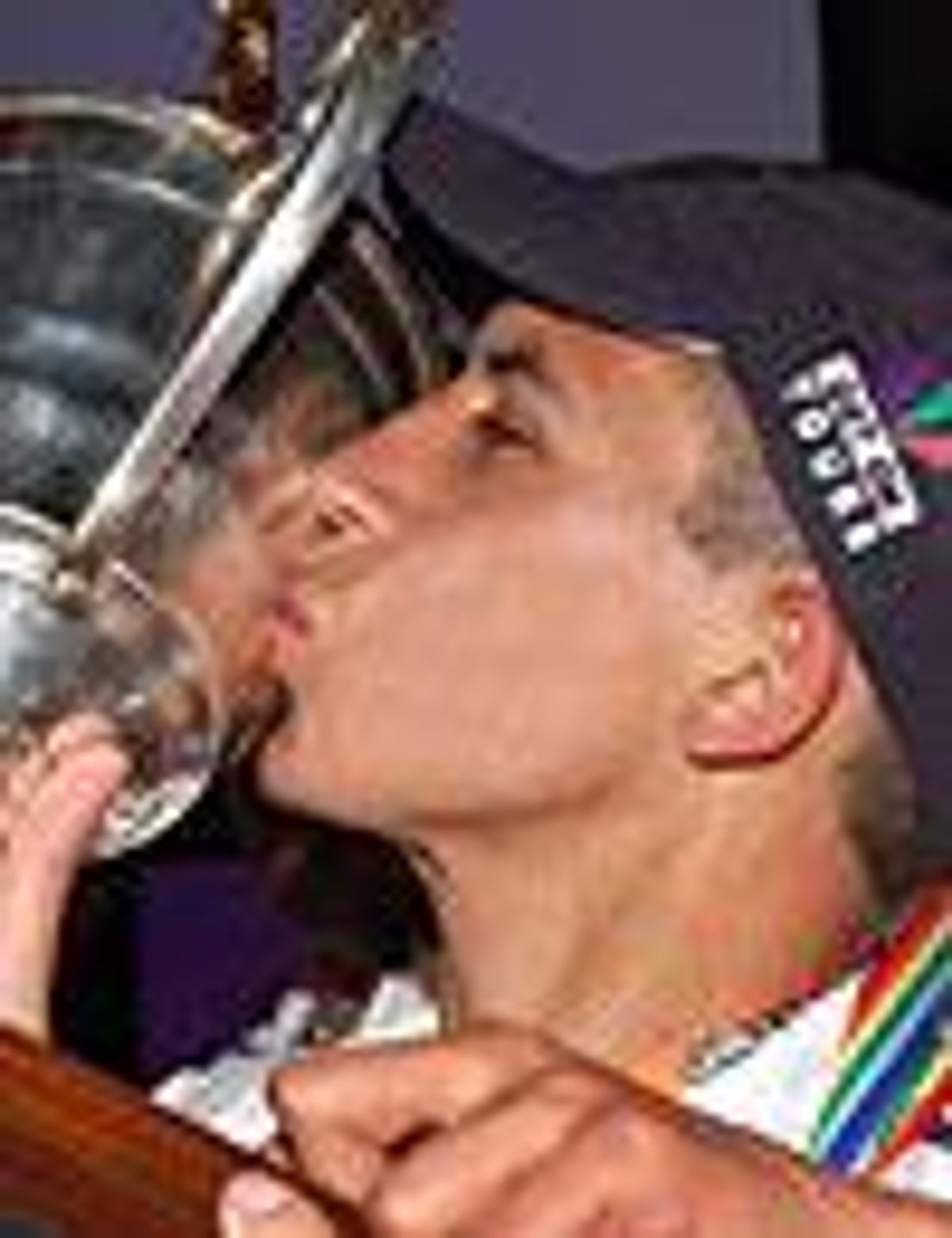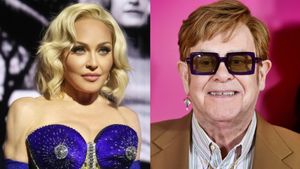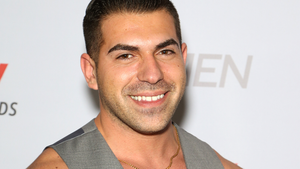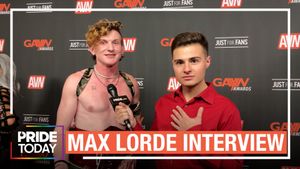Hundreds of
buffed-out guys packed their bags and descended on Buenos
Aires the last week of September in hopes of
scoring...a goal. Twenty-eight teams representing 18
countries competed in the International Gay and
Lesbian Football Association World Championship
tournament in Argentina. Or, as we call it in the
States, soccer. This is the first time a South
American country has played host to the event, which
had the biggest turnout of teams in the
championship's 16-year history. Athletes from
Australia, the U.S., and across Europe came to Buenos
Aires; Iceland, Uruguay, Chile, and Mexico made their
first appearances at the international competition.
Sorry to say, the women's event was canceled after
not garnering enough teams to make it a viable
competition. A few women did get to play, though, in a
couple of "mixed" teams.
In a country
where football is more than just a sport, many might think
there would be a lot of opposition to hosting the gay
athletic competition in this heavily Catholic country.
It was just the opposite.
Argentina's
football association endorsed the gay competition. It backed
up that endorsement by donating all of the uniforms for the
Argentinean teams, providing referees for the matches,
and allowing the championship match to be played at
its official stadium. Imagine an American sports
organization like the NFL or NBA sponsoring a gay or lesbian
athletic competition?
Generous
corporate sponsors were not hard to come by, either. Delta
Air Lines stepped up to be the championships'
primary sponsor; officials from the company also used
the event as an opportunity to introduce its new
Web
site that caters to gay and lesbian travelers.
Though the play
on the field was serious and determined, the city of
Buenos Aires was not. The people were extremely gracious
hosts, and every district we visited was very
progressive and gay-friendly. That may be due in part
to Argentina's capital becoming the first city in
Latin America to legally recognize same-sex couples.
Away from the
competition, players got to kick off their cleats and take
in the sights of the refreshingly beautiful and clean
city. My boyfriend and I decided to visit
San Telmo square, one of the city's oldest
neighborhoods. The narrow streets are stone-paved, and the
buildings lining the corridors are a mixture of old-world
Spanish and Italian architecture with a little bit of
New Jersey sprinkled here and there. The usually
laid-back neighborhood takes on an entirely different
feel on Sundays, when it becomes home to the city's
largest antique flea market.
When entering the
market, visitors are serenaded by street orchestras
(sometimes as many as 15 instruments) playing distinctive
tango music along the 20-block stretch. It's
here where shoppers can find that uniquely Argentine
item for a really inexpensive price. The music also
creates the sound track for street performers who captivate
crowds with precise tango dances. If you are the
adventurous type, for only 10 pesos ($3 U.S.) you can
have an impromptu tango lesson from one of the locals
and snap a couple pics.
If antiques
aren't your thing, check out Florida Street. Bargain
shopping is a snap here, since the Argentine peso is
exchanging for a little over 3 to the U.S.
dollar, so it goes a long way in purchasing those
essentials for fall. Located in the El Centro district,
Florida Street (pronounced "Flor-ee-da") is home to
many factory outlets and little boutiques. The
shopping is fantastic, except for the very aggressive
salespeople who literally come out of their shops to try to
escort you into their stores. The street also had that Las
Vegas feel to it, as guys would hand you a flyer with
"Girls, Girls, Girls" written across the
top.
Along with Evita
and soccer, Argentina is also known for inexpensive
leather products. I was able to purchase an incredibly soft
three-quarter-length leather jacket with silk lining for
$150, and another great buy was an embroidered
T-shirt for about $10. Cashmere sweaters are a steal
at approximately 20 bucks for solid colors, and it's
$30 for that hot fall look, argyle. If you are looking for
an early-winter getaway, Buenos Aires is the place to
get all of your Christmas shopping done at clearance
sale prices (it will be approaching summer there).
After shopping to
exhaustion, we grabbed a bite to eat a few blocks from
Florida Street at El Palacio de la Papa Frita (there are
multiple locations; we went to Lavalle 954). The name
reflects the mom-and-pop atmosphere of the restaurant.
Though the fluorescent lights were slightly
off-putting, the food made up for the lack of ambiance.
Friendly waiters greeted us with a handshake and smile
upon entering the surprisingly busy restaurant. Keep
in mind, people in Argentina eat later than most
Americans. Lunch is usually around 2 p.m., and dinner
doesn't start until 9 or 10 p.m.
Since Argentina
is world-renowned for its fantastic steak and wine, I
thought I'd put that reputation to the test.
Heeding the recommendation of the staff, I tried a
2003 Terza Volta Malbec, which is produced in the
province of Mendoza. The full-bodied red wine had a
raspberry aroma with a very subtle and smooth taste. It
really complemented the taste of my amazingly tender
12-ounce steak.
The dinner had
only one slight hiccup: In Buenos Aires, don't assume
salad comes with lettuce. Making that assumption, I ordered
tomatoes, cucumbers, and carrots, and that's
exactly what I got. The waiter did, however, ask me if
I would like my lettuce-less salad tossed with olive
oil, but I politely declined. For dessert I ordered a flan
confection that was topped off with homemade whipped
cream and a spoonful of caramel on the side. It was
amazingly sweet but delicious. Total price for the
three-course meal (including wine) was 39 pesos, or $12. No
wonder this restaurant is a local favorite.
After loading up
on calories and destroying our diets, we walked to one
of the most famous and beautiful parts of Buenos Aires,
Plaza de Mayo. The square is constructed so that you
can stand in the middle of the square and turn 360
degrees looking up corridors that give you glimpses
of parliament, the national cathedral, monuments like
the Obelisco, the national library, and other
buildings of national importance. Many of the office
buildings surrounding the square are stunning, resembling
the Plaza Hotel in New York City.
The crown jewel
of the square is Casa Rosada. It sort of resembles the
Barbie dream house my sister had growing up. Any wonder
Buenos Aires is so queer-friendly? Instead of a White
House, the president of Argentina lives in a "Pink
House." More importantly, as every good queen knows,
it is where Madonna filmed Evita and sang
"Don't Cry for Me Argentina."
It was a far
different scene at the stadium where the finals were played.
Hundreds of rowdy fans, family members, activists, and
eliminated team members filed in to watch the bronze
medal match between the West Hollywood Eclipse and the
London Titans. West Hollywood pulled out an exciting
5-4 victory in a penalty kick shoot-out.
In the
championship match between Los Dogos (Argentina) and
Stonewall FC (England), the Argentina club won,
1-0. And even though my hometown team, the
Seattle Rain, didn't do as well I had hoped, there
were definitely no tears shed in Argentina.


















































































